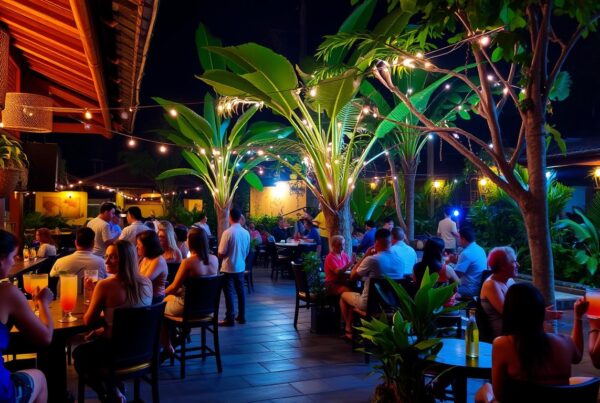Bali’s a ripper island getaway with something for everyone. From stunning beaches to lush jungles, this tropical paradise has it all. Beach bums, culture vultures, and adventure seekers will find their bliss here.
Bali’s popularity has transformed areas like Seminyak and Canggu. It’s still budget-friendly compared to Europe or the Americas. The warm climate makes it a year-round destination.
June to August are the most popular months for visitors. These months offer the driest weather for outdoor activities.
Bali caters to all budgets with various accommodation options. You’ll find budget-friendly hostels, luxe 5-star resorts, and unique Airbnb villas.
Each region offers a distinct vibe. Ubud is perfect for culture lovers. Canggu attracts surfers. Uluwatu boasts exclusive stays.
Don’t miss Seminyak’s beach clubs. Jimbaran’s seafood feasts at sunset are a must-try experience.
Key Takeaways
- Bali offers diverse experiences from beaches to cultural sites
- June to August are the most popular and driest months to visit
- Accommodation options suit all budgets and preferences
- Each region in Bali has its unique attractions and atmosphere
- Bali’s Hindu culture sets it apart from the rest of Indonesia
- The island is popular among digital nomads and luxury seekers alike
Understanding Bali’s Unique Culture and Geography
Bali offers a captivating mix of Balinese culture and scenic landscapes. Visitors are drawn to the island’s blend of tradition and natural beauty.
The Island of Gods: Balinese Hinduism
Balinese Hinduism is central to the island’s cultural identity. It shapes daily life with colourful offerings and ceremonies. Temples, both large and small, are key to spiritual practices.
Diverse Landscapes: From Beaches to Volcanoes
Bali boasts a stunning mix of coastal and inland wonders. Golden beaches line the south, while lush rice terraces paint central regions green.
The island’s heart features volcanic peaks, including the majestic Mount Agung.
Key Regions: Ubud, Seminyak, Canggu, and Beyond
Each area of Bali offers a unique experience:
- Ubud: A hub for arts and culture, surrounded by emerald rice paddies
- Seminyak: Known for upscale resorts and stylish beach clubs
- Canggu: A trendy surf town with a laid-back vibe
- Uluwatu: Home to clifftop temples and world-class surf breaks
| Region | Known For | Ideal For |
|---|---|---|
| Ubud | Art galleries, rice terraces | Culture enthusiasts, nature lovers |
| Seminyak | Luxury resorts, fine dining | Upscale travellers, foodies |
| Canggu | Surf spots, hipster cafes | Surfers, digital nomads |
| Uluwatu | Clifftop temples, sunset views | Photographers, spiritual seekers |
Bali’s diverse regions cater to all tastes. You’ll find everything from spiritual retreats to vibrant nightlife.
Every visitor can discover their perfect slice of paradise on this island.
Best Times to Visit Bali
Timing is crucial for your Bali trip. This tropical paradise offers unique experiences all year round. Let’s explore the best times to visit this stunning island.
The dry season runs from May to October. May, June, and September are ideal, with great weather and fewer tourists. It’s perfect for outdoor activities and beach-hopping.
Surf enthusiasts should visit from April to September. Divers will enjoy May to November. October is best for spotting majestic Manta Rays.
The wet season lasts from November to April. It brings lush landscapes and cultural events. December and January see the most rainfall.
| Season | Months | Best For | Average Temperature |
|---|---|---|---|
| Dry Season | May – October | Beach activities, surfing, outdoor exploration | 27°C – 30°C |
| Wet Season | November – April | Lush scenery, fewer tourists, cultural events | 31°C |
Bali is popular, with over two million visitors in 2022. For a quieter trip, visit during shoulder seasons. October-November or February-March are great options.
Planning Your Bali Trip Itinerary
Bali offers a mix of culture, beaches, and adventure for every traveller. The island boasts over 1,000 temples, numerous beaches, and diverse landscapes. Most visitors spend 10 to 14 days exploring Bali’s rich culture and natural beauty.
Must-Visit Temples and Cultural Sites
Bali’s temples are the heart of its spiritual culture. Iconic sites like Tanah Lot and Pura Luhur Uluwatu are must-see attractions. These ancient structures offer stunning views and insights into Balinese Hinduism.
For a more peaceful experience, plan your visits during less crowded times.
Beach Hopping and Water Activities
Bali’s coastline is a paradise for beach lovers and water sports fans. Seminyak and Jimbaran offer stunning sunsets and beachside retreats. Canggu is perfect for surfing enthusiasts seeking adventure.
Snorkelling off Nusa Penida reveals vibrant marine life in crystal-clear waters.
Exploring Ubud’s Art Scene and Rice Terraces
Ubud, Bali’s cultural heart, is a must-visit destination. Explore its many art galleries and watch traditional dance performances. The nearby Tegalalang Rice Terraces showcase Bali’s agricultural beauty.
A trip to Ubud from Canggu takes about 2.5 hours and costs around 120,000 Rp by Grab.
| Activity | Location | Recommended Time |
|---|---|---|
| Temple Visit | Tanah Lot | Sunset |
| Surfing | Canggu | Morning |
| Art Exploration | Ubud | Afternoon |
| Rice Terrace Visit | Tegalalang | Early Morning |
July, August, and December are peak seasons in Bali. Visiting during shoulder seasons offers a more relaxed experience. You’ll also find better rates for accommodation and activities during these times.
Accommodation Options for Every Budget
Bali has accommodation for all travellers. You’ll find options from cheap hostels to fancy resorts. This island caters to every budget.
Bali’s luxury resorts offer a lavish experience. They often have private beaches, infinity pools, and personal service. Prices range from $100 to $1000+ USD per night.
Mid-range options provide great value. Comfortable hotels and resorts cost $50 to $100 USD nightly. They balance comfort with affordability.
Budget travellers have plenty of choices in Bali. Hostels and guesthouses can cost as little as $11 USD per night. Canggu and Uluwatu offer cheap options from 65K to 100K IDR nightly.
| Accommodation Type | Price Range (per night) | Best Locations |
|---|---|---|
| Luxury Resorts | $100 – $1000+ | Nusa Dua, Jimbaran, Seminyak |
| Mid-range Hotels | $50 – $100 | Ubud, Sanur, Legian |
| Budget Hostels | $11 – $30 | Kuta, Canggu, Uluwatu |
| Family Rooms | $20 – $30 | Nusa Dua, Sanur |
Families can find cozy rooms in Nusa Dua or Sanur. Family rooms cost between 340K-500K IDR per night. These areas blend relaxation with fun family activities.
Bali’s diverse accommodation suits all needs. You’re sure to find the perfect place for your island getaway.
Navigating Bali’s Transportation
Bali’s diverse landscapes are a key part of any island getaway. Efficient transport enhances your adventure tourism experience. Let’s explore the best ways to navigate this tropical paradise.
Hiring a Scooter: Tips and Precautions
Renting a scooter is popular for budget-conscious travellers. A 125cc scooter costs between 60,000 to 100,000 IDR per day. Fuel is cheap, with most spending under $2 daily.
Safety comes first. Always wear a helmet and secure proper insurance. An International Driver’s Permit is mandatory for legal riding in Bali.
Utilising Ride-Sharing Apps and Taxis
Grab and Gojek dominate ride-hailing in Bali. Grab is often preferred for its affordability. Trips cost about half to a third of similar journeys elsewhere.
Grab cars are typically nicer than traditional taxis. Most drivers speak English. For a budget-friendly option, try Gojek’s motorbike taxis.
Arranging Private Drivers for Day Trips
For longer excursions or day tours, hiring a private driver is comfortable. Car rentals start at around 200,000 IDR per day. Additional costs apply for drivers.
This choice offers flexibility to explore remote areas. It’s perfect for those seeking unique adventure tourism experiences off the beaten path.
| Transport Option | Average Cost (IDR) | Best For |
|---|---|---|
| Scooter Rental | 60,000 – 100,000/day | Budget travellers, short distances |
| Grab/Gojek | Varies (cheaper than taxis) | City travel, convenience |
| Private Driver | 200,000+/day | Day trips, group travel |
Balinese Cuisine: What to Eat and Drink

Bali’s food scene is a colourful mix of tastes. It offers something for everyone, from cheap eats to fancy meals. The island is a food lover’s dream come true.
Local dishes like Babi Guling and Nasi Campur are must-try foods. Coastal areas serve up fresh seafood that’s sure to please. Ubud is great for vegans, offering plant-based versions of traditional meals.
Bali’s drinks are just as exciting as its food. Bintang beer is popular, starting at $2 for a small bottle. For a unique sip, try Kopi Luwak, the famous civet coffee.
Stick to bottled water for drinking and brushing teeth. This helps avoid getting sick, which locals call ‘Bali Belly’.
| Drink | Price (USD) |
|---|---|
| Bintang Beer (Small) | $2 |
| Bintang Beer (Large) | $4 |
| Spirits with Mixer | $7 |
| Arak (Local Liquor) | $1.50 per bottle |
Food prices range from cheap to expensive. Local warungs serve meals for a few dollars. High-end restaurants charge $5 to $50 per plate.
Halal food is easy to find, especially in Denpasar and Kuta. Vegetarians and vegans have lots of choices across the island. Bali truly caters to all food preferences.
Cultural Etiquette and Respectful Tourism
Balinese culture is essential for an unforgettable island trip. Bali’s Hindu majority makes it unique among Indonesia’s 300 ethnic groups. Learning local customs helps you show respect during your visit.
Dressing Appropriately at Temples
Cover shoulders and knees when visiting temples. Many sacred sites offer sarongs for visitors. Avoid topless attire, even in tourist areas.
Modest dress shows respect for Balinese traditions. It’s a simple way to honour the local culture.
Understanding Local Customs
Balinese customs reflect deep-rooted traditions. Use your right hand for eating and passing objects. The left hand is considered unclean.
Public displays of affection are not welcome. Remove shoes when entering homes. Queueing patiently is good manners in Bali.
Participating in Traditional Ceremonies
Dress modestly if invited to a ceremony. Follow local guidance at these events. Licensed guides can help you navigate temple visits.
Don’t step on or touch offerings (canang sari) on the ground. These are sacred items in Balinese culture.
| Do’s | Don’ts |
|---|---|
| Dress modestly | Wear revealing clothing |
| Use right hand for exchanges | Use left hand for eating or passing objects |
| Remove shoes when entering homes | Step on offerings |
| Learn basic Balinese phrases | Disrespect religious sites |
Respecting these customs will enhance your Bali experience. It helps create positive interactions with locals. Remember, most Balinese earn less than $300 USD monthly.
Be mindful of your impact as a visitor. Your actions can make a big difference in this beautiful culture.
Adventure Activities and Wellness Experiences
Bali’s diverse landscape is a playground for adventure seekers. From surfing in Uluwatu to hiking Mount Batur, the island offers thrills for all. White water rafting in Ubud and diving in Amed are popular adrenaline-pumping activities.
Bali is also a haven for wellness and relaxation. Many resorts offer Yoga Escape packages, combining yoga, healthy eating, and holistic therapies.

Mason Adventures is Bali’s longest-established adventure tour operator. With 35 years of experience, they provide safe, eco-friendly adventures across the island. Their ‘5-Star’ facilities ensure top-notch service for all guests.
| Activity | Location | Highlights |
|---|---|---|
| Surfing | Uluwatu | World-class waves, stunning cliffs |
| Hiking | Mount Batur | Sunrise views, active volcano |
| White Water Rafting | Ubud | Scenic river gorges, thrilling rapids |
| Diving | Amed | Colourful coral reefs, diverse marine life |
| Yoga Retreat | Various locations | Balinese Healing Yoga, Anti-Gravity Yoga |
Wellness seekers can enjoy morning yoga classes and Balinese Healing Yoga sessions. Anti-Gravity Yoga is another unique option to try. These activities often come with organic cooking classes and cultural visits.
Guests can explore local Balinese house compounds for a taste of authentic culture. This holistic approach combines wellbeing with immersive cultural experiences.
Practical Tips for a Smooth Bali Trip
Ready for a Bali adventure? These tips will help you navigate the island like a pro. Get ready for a seamless tropical experience!
Handling Money and ATMs
Bali uses Indonesian Rupiah (IDR) as its currency. Use major bank ATMs to avoid fees. Don’t forget your card after getting cash.
Keep some cash handy for small purchases. Many areas don’t accept cards, so be prepared.
Staying Safe and Healthy
Bali’s rainy season is from November to March. Use mosquito repellent, especially during this time. Consider Hepatitis A and typhoid vaccinations before your trip.
Major hospitals are in Denpasar and Ubud. Travel insurance from World Nomads or Allianz is a smart choice.
Dealing with the New Tourist Tax
Since February 2024, Bali has a new tourist tax. Visitors pay 150,000 IDR (about 15 AUD) on arrival. This is separate from the e-VoA fee.
The Electronic Visa on Arrival (e-VoA) costs 500,000 IDR for those needing a visa.
| Item | Cost (IDR) | Cost (AUD) |
|---|---|---|
| Tourist Tax | 150,000 | 15 |
| e-VoA (if required) | 500,000 | 50 |
| e-VoA Processing Fee | 19,500 | 2 |
Peak tourist seasons are July-August and December. Book early to snag the best deals on flights and accommodation.
Conclusion
Bali offers a unique mix of culture and tropical beauty. It was named the world’s top destination by TripAdvisor in 2017. Bali’s Hindu traditions stand out in mostly Muslim Indonesia.
Ubud is a spiritual centre, while Canggu charms with its coastal vibe. These diverse regions cater to all types of travellers. Bali’s economy relies heavily on tourism, making up 65% of its GDP.
The island faces some challenges after Covid. Price hikes and traffic jams can affect visits. But smart planning can still lead to affordable luxuries.
To make the most of Bali, go beyond popular spots. Visit the Tegalalang Rice Terrace or trek Mount Batur at sunrise. Relax in the Banjar Hot Springs for a different experience.
Immerse yourself in local culture and nature for lasting memories. Respect local customs and support sustainable tourism. This helps preserve Bali’s beauty for future visitors.



